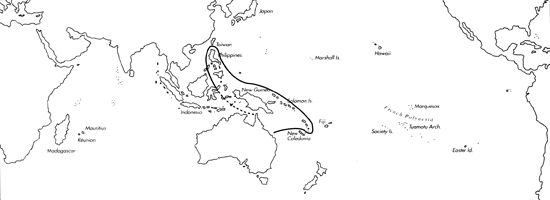Range: Philippines to New Guinea, Solomon Is., Queensland, and Vanuatu.
Description: Moderately small to medium-sized, moderately light to moderately solid. Last whorl conical to ventricosely conical; outline convex adapically, almost straight below; left side slightly concave at base. Basal part of columella sometimes deflected to left. Shoulder sharply angulate. Spire of moderate height, slightly stepped, outline concave. Larval shell of about 3 whorls, maximum diameter about 0.7 mm. First 2-4 postnuclear whorls tuberculate. Teleoconch sutural ramps almost flat, with 0-1 increasing to 5-9 spiral grooves. In specimens from Philippines, New Guinea and Solomon Is. (Pl. 46, Figs. 25-27), last whorl with variably spaced, axially striate to punctate spiral grooves below centre, occasionally to shoulder, separated by ribs at anterior end and by ribbons above; grooves may contain spiral threads and ribbons may be partially subdivided in 2-3 narrower elevations. Specimens from Vanuatu (Pl. 46, Fig. 28) with a more prominent spiral sculpture from base to shoulder.
| Shell Morphometry | ||
|---|---|---|
| L | 33-50 mm | |
| RW | 0.08-0.18 g/mm | |
| (L 34-42 mm) | ||
| RD | 0.52-0.62 | |
| PMD | 0.82-0.90 | |
| RSH | 0.13-0.22 | |
Ground colour white. Last whorl with evenly spaced yellowish to reddish brown dotted, dashed or solid spiral lines. Axial streaks or blotches occasionally form a spiral band above centre and traces of bands at shoulder and near base. Larval whorls white. Early postnuclear sutural ramps white to brownish beige, often immaculate; following sutural ramps with brown radial streaks. Shells heavily patterned on last whorl and spire intergrade with completely white shells. Aperture white.
Periostracum olive-brown, translucent to nearly opaque, rather smooth.
Dorsum of foot mottled white and light grey, grading to brownish yellow anteriorly, sometimes flecked with brown; lighter median zone set off from darker latero-posterior margin by a thin brown line; a white spot beneath the operculum. Sole of foot light grey. Rostrum pale brown. Tentacles white, with a white or black tip. Siphon grayish white, dorso-laterally mottled or flecked with brown (Chaberman, pers. comm., 1981; Richards, 1988)(Pl. 76, Fig. 52; Pl.82, Third row, left). We consider the assignment of the 2 specimens studied by Bergh (1895) to C. mucronatus to be doubtful until the structure of the radular teeth is verified by future studies.
Habitat and Habits: Usually in 3-50 m, more common below 20 m. In Philippines, in 120-400 m (Guillot de Suduiraut, pers. comm., 1992). Populations from upper subtidal mostly on muddy sand (Chaberman, pers. comm., 1981; Richards, 1988; pers. comm., 1989).
Discussion: C. mucronatus may be confused with C. scalptus, C. alabaster, C. asiaticus. C. leobrerai, and C. sculpturatus. C. scalptus is a smaller species (to 28 mm), its shoulder is subangulate to rounded, the spiral lines on its last whorl are finer and often dashed, and its early postnuclear whorls are not tuberculate. C. alabaster differs in having a lower spire (RSH 0.10-0.14) that is rather flat in the latest whorls, and in more prominent spiral sculpture on the last whorl, consisting of narrow ribs rather than broad ribbons: its surface is usually immaculate white. Sometimes with small radial marking. For comparison with C. asiaticus, C. leobrerai, and C. sculptulratus, see the Discussions of those species.

C. mucronatus range map
This section contains verbatim reproductions of the accounts of 316 species of Conus from the Indo-Pacific region, from Manual of the Living Conidae, by Röckel, Korn and Kohn (1995). They are reproduced with the kind permission of the present publisher, Conchbooks.
All plates and figures referred to in the text are also in Röckel, Korn & Kohn, 1995. Manual of the Living Conidae Vol. 1: Indo-Pacific Region.
The range maps have been modified so that each species account has it own map, rather than one map that showed the ranges of several species in the original work. This was necessary because each species account is on a separate page on the website and not confined to the order of accounts in the book.